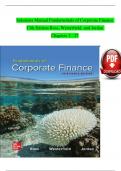Solutions Manual Fundamentals of Corporate Finance
13th Edition Ross, Westerfield, and Jordan
Chapters 1 - 27
,CHAPTER71:7Introduction7to7Corporate7Finance
CHAPTER72:7Financial7Statements,7Taxes,7And7Cash7Flow
CHAPTER73:7Working7with7Financial7Statements
CHAPTER74:7Long-Term7Financial7Planning7and7Growth
CHAPTER75:7Introduction7to7Valuation:7The7Time7Value7of7Money
CHAPTER76:7Discounted7Cash7Flow7Valuation
CHAPTER77:7Interest7Rates7and7Bond7Valuation
CHAPTER78:7Stock7Valuation
CHAPTER79:7Net7Present7Value7and7Other7Investment7Criteria
CHAPTER710:7Making7Capital7Investment7Decisions
CHAPTER711:7Project7Analysis7and7Evaluation
CHAPTER712:7Some7Lessons7from7Capital7Market7History
CHAPTER713:7Return,7Risk,7And7the7Security7Market7Line
CHAPTER714:7Cost7of7Capital
CHAPTER715:7Raising7Capital
CHAPTER716:7Financial7Leverage7and7Capital7Structure7Policy
CHAPTER717:7Dividends7and7Payout7Policy
CHAPTER718:7Short-Term7Finance7and7Planning
CHAPTER719:7Cash7and7Liquidity7Management
CHAPTER720:7Credit7and7Inventory7Management
CHAPTER721:7International7Corporate7Finance
CHAPTER722:7Behavioral7Finance:7Implications7for7Financial7Manage
CHAPTER723:7Enterprise7Risk7Management
CHAPTER724:Options7and7Corporate7Finance
CHAPTER725:7Option7Valuation
CHAPTER726:7Mergers7and7Acquisitions
CHAPTER727:7Leasing
,CHAPTER 1 7
INTRODUCTION TO CORPORATE 7 7 7
FINANCE
Answers7to7Concepts7Review7and7Critical7Thinking7Questions
1. Capital7budgeting7(deciding7whether7to7expand7a7manufacturing7plant),7capital7structure7(deciding7wh
ether7to7issue7new7equity7and7use7the7proceeds7to7retire7outstanding7debt),7and7working7capital7manage
ment7(modifying7the7firm‘s7credit7collection7policy7with7its7customers).
2. Disadvantages:7unlimited7liability,7limited7life,7difficulty7in7transferring7ownership,7hard7to7raise7capit
al7funds.7Some7advantages:7simpler,7less7regulation,7the7owners7are7also7the7managers,7sometimes7per
sonal7tax7rates7are7better7than7corporate7tax7rates.
3. The7primary7disadvantage7of7the7corporate7form7is7the7double7taxation7to7shareholders7of7distributed7e
arnings7and7dividends.7Some7advantages7include:7limited7liability,7ease7of7transferability,7ability7to7rai
se7capital,7unlimited7life,7and7so7forth.
4. In7response7to7Sarbanes-
Oxley,7small7firms7have7elected7to7go7dark7because7of7the7costs7of7compliance.7The7costs7to7comply7w
ith7Sarbox7can7be7several7million7dollars,7which7can7be7a7large7percentage7 of7 a7 small7 firms7 profits.7 A
7 major7 cost7 of7 going7 dark7 is7 less7 access7 to7 capital.7 Since7 the7firm7is7no7longer7publicly7traded,7it7can7
no7longer7raise7money7in7the7public7market.7Although7the7company7will7still7have7access7to7bank7loans
7and7the7private7equity7market,7the7costs7associated7with7raising7funds7in7these7markets7are7usually7hig
her7than7the7costs7of7raising7funds7in7the7public7market.
5. The7 treasurer‘s7 office7 and7 the7 controller‘s7 office7 are7 the7 two7 primary7 organizational7 groups7 that7r
eport7directly7to7the7chief7financial7officer.7The7controller‘s7office7handles7cost7and7financial7accountin
g,7tax7management,7and7management7information7systems,7while7the7treasurer‘s7office7is7responsible7
for7 cash7 and7 credit7 management,7 capital7 budgeting,7 and7 financial7 planning.7 Therefore,7the7study7of7
corporate7finance7is7concentrated7within7the7treasury7group‘s7functions.
6. To7maximize7the7current7market7value7(share7price)7of7the7equity7of7the7firm7(whether7it‘s7publicly-
7traded7or7not).
7. In7the7corporate7form7of7ownership,7the7shareholders7are7the7owners7of7the7firm.7The7shareholders7elec
t7the7directors7of7the7corporation,7who7in7turn7appoint7the7firm‘s7management.7This7separation7of7own
ership7from7control7in7the7corporate7form7of7organization7is7what7causes7agency7problems7to7exist.7Ma
nagement7may7act7in7its7own7or7someone7else‘s7best7interests,7rather7than7those7of7the7shareholders.7If7
such7events7occur,7they7may7contradict7the7goal7of7maximizing7the7share7price7of7the7equity7of7the7fir
m.
8. A7primary7market7transaction.
, B-27 SOLUTIONS
9. In7auction7markets7like7the7NYSE,7brokers7and7agents7meet7at7a7physical7location7(the7exchange)7to7m
atch7buyers7and7sellers7of7assets.7Dealer7markets7like7NASDAQ7consist7of7dealers7operating7at7dispers
ed7locales7who7buy7and7sell7assets7themselves,7communicating7with7other7dealers7either7electronically
7or7literally7over-the-counter.
10. Such7organizations7frequently7pursue7social7or7political7missions,7so7many7different7goals7are7conceiv
able.7One7goal7that7is7often7cited7is7revenue7minimization;7i.e.,7provide7whatever7goods7and7services7a
re7offered7at7the7lowest7possible7cost7to7society.7A7better7approach7might7be7to7observe7that7even7a7not
-for-
profit7business7has7equity.7Thus,7one7answer7is7that7the7appropriate7goal7is7 to7maximize7the7value7of7t
he7equity.
11. Presumably,7the7current7stock7value7reflects7the7risk,7timing,7and7magnitude7of7all7future7cash7flows,7b
oth7short-term7and7long-term.7If7this7is7correct,7then7the7statement7is7false.
12. An7argument7can7be7made7either7way.7At7the7one7extreme,7we7could7argue7that7in7a7market7economy,7a
ll7of7these7things7are7priced.7There7is7thus7an7optimal7level7of,7for7example,7ethical7and/or7illegal7behav
ior,7and7the7framework7of7stock7valuation7explicitly7includes7these.7At7the7other7extreme,7we7could7arg
ue7that7these7are7non-
economic7phenomena7and7are7best7handled7through7the7political7process.7A7classic7(and7highly7releva
nt)7thought7question7that7illustrates7this7debate7goes7something7like7this:7―A7firm7has7estimated7that7th
e7cost7of7improving7the7safety7of7one7of7its7products7is7$307million.7However,7the7firm7believes7that7im
proving7the7safety7of7the7product7will7only7save7$207million7in7product7liability7claims.7What7should7t
he7firm7do?‖
13. The7goal7will7be7the7same,7but7the7best7course7of7action7toward7that7goal7may7be7different7because7of7d
iffering7social,7political,7and7economic7institutions.
14. The7goal7of7management7should7be7to7maximize7the7share7price7for7the7current7shareholders.7If7manag
ement7believes7that7it7can7improve7the7profitability7of7the7firm7so7that7the7share7price7will7exceed7$35,7
then7they7should7fight7the7offer7from7the7outside7company.7If7management7believes7that7this7bidder7or7
other7unidentified7bidders7will7actually7pay7more7than7$357per7share7to7acquire7the7company,7then7the
y7should7still7fight7the7offer.7However,7if7the7current7management7cannot7increase7the7value7of7the7fir
m7beyond7the7bid7price,7and7no7other7higher7bids7come7in,7then7management7is7not7acting7in7the7intere
sts7of7the7shareholders7by7fighting7the7offer.7Since7current7managers7often7lose7their7jobs7when7the7cor
poration7is7acquired,7poorly7monitored7managers7have7an7incentive7to7fight7corporate7takeovers7in7situ
ations7such7as7this.
15. We7would7expect7agency7problems7to7be7less7severe7in7other7countries,7primarily7due7to7the7relatively7s
mall7percentage7of7individual7ownership.7Fewer7individual7owners7should7reduce7the7number7of7diver
se7opinions7concerning7corporate7goals.7The7high7percentage7of7institutional7ownership7might7lead7to7
a7higher7degree7of7agreement7between7owners7and7managers7on7decisions7concerning7risky7projects.7I
n7addition,7institutions7may7be7better7able7to7implement7effective7monitoring7mechanisms7on7manager
s7than7can7individual7owners,7based7on7the7institutions‘7deeper7resources7and7experiences7with7their7o
wn7management.7The7increase7in7institutional7ownership7of7stock7in7the7United7States7and7the7growing
7activism7of7these7large7shareholder7groups7may7lead7to7a7reduction7in7agency7problems7for7U.S.7corpo
rations7and7a7more7efficient7market7for7corporate7control.




